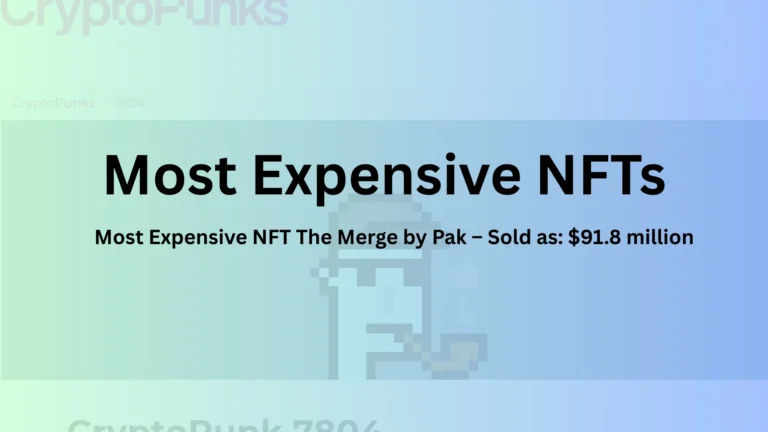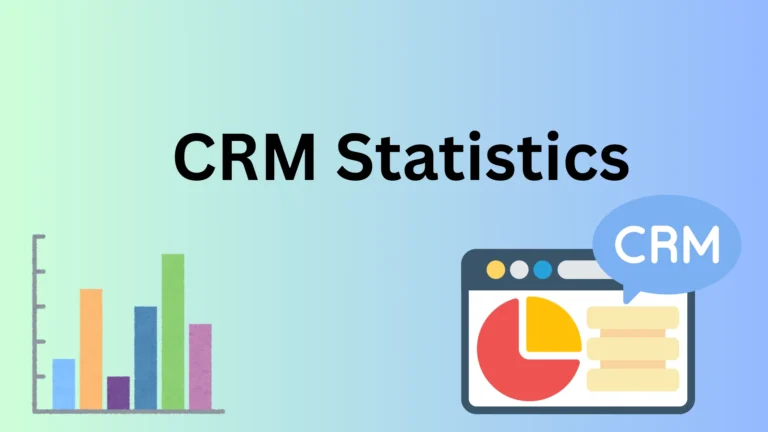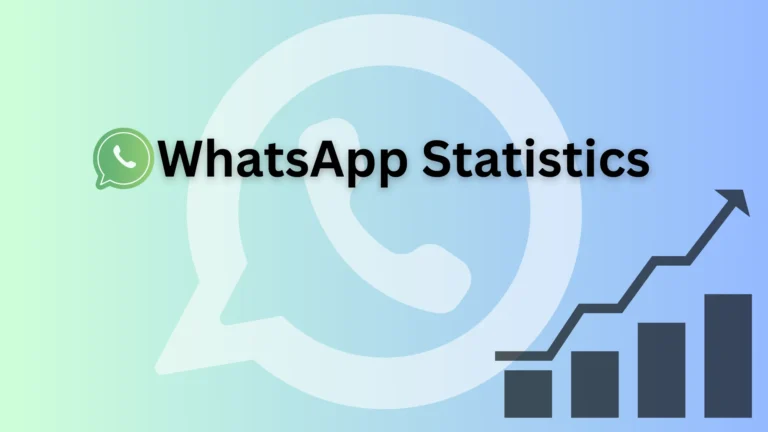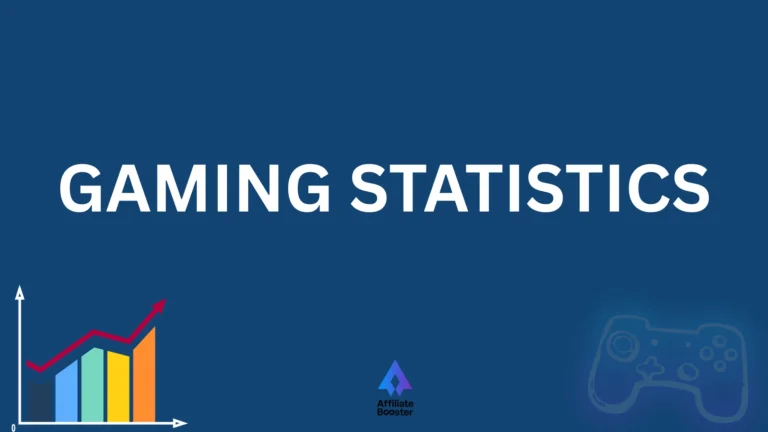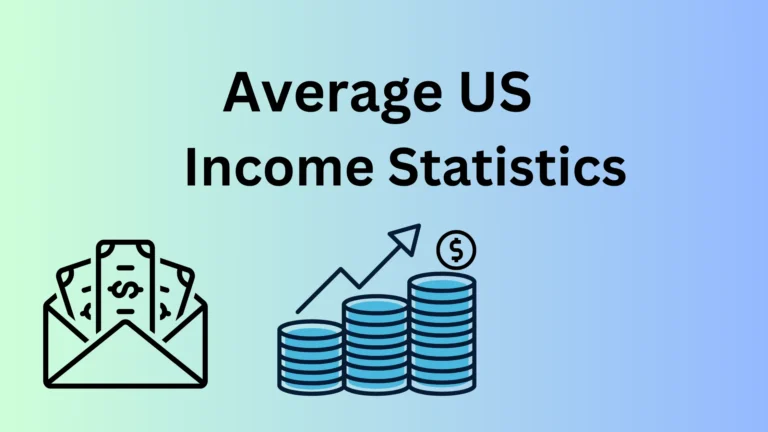Tinder has changed how people meet, turning the simple swipe into a global habit. With over 70 million users and 1.6 billion swipes each day, it’s clear many are giving online dating a shot.
These swipes create 26 million matches daily, though only 1 in 10 leads to a real date. About 54% of users seek something serious, while 30% prefer casual connections.
Men outnumber women three to one, and the average user spends 35 minutes a day on the app. Behind all the matches and chats is a massive business. Let’s take a look at Tinder statistics for 2026.
Little Quick Facts about Tinder Statistics
- Tinder connects over 70 million active users from across the globe every single day.
- Users make a combined 1.6 billion swipes daily, searching for potential matches.
- Roughly 26 million romantic matches are made each day through Tinder’s swiping feature.
- Only about 10% of these matches turn into actual, in-person dates.
- Over half of users, around 54%, are genuinely looking for long-term relationships.
How Many People are using Tinder in 2026?
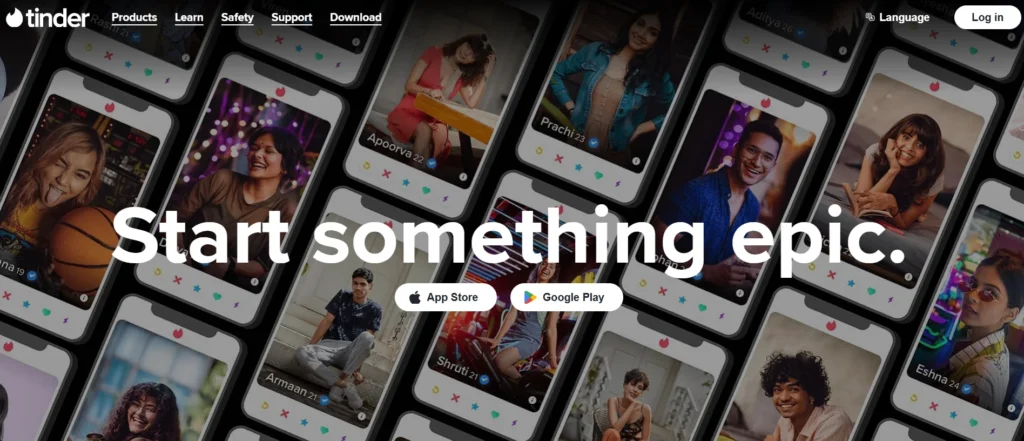
First, let's start with the headline numbers. Tinder's user base is enormous, making it one of the most popular social apps on the planet.
- As of 2025, Tinder has around 60 million monthly active users (MAU) worldwide.
- Of those millions of users, 9.6 million are paying subscribers.
These paying subscribers are the core of Tinder's business model. They pay for premium features that give them an edge in the dating game. However, the number of subscribers has seen a slight dip in recent years.
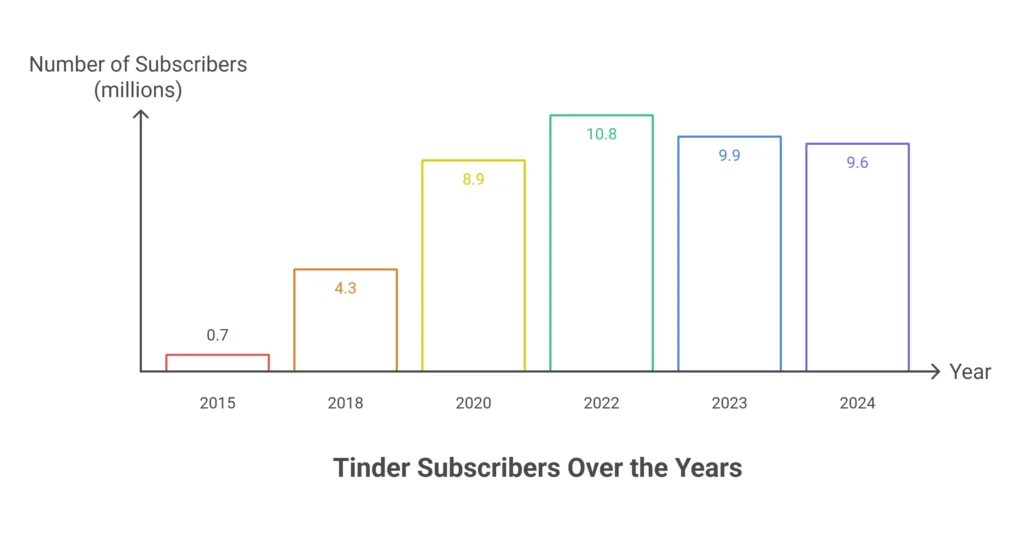
| Year | Number of Subscribers (in millions) | What This Shows |
| 2015 | 0.7 | The very beginning of its growth. |
| 2018 | 4.3 | Rapid adoption and the start of its monetization success. |
| 2020 | 8.9 | The pandemic likely boosted online dating, pushing numbers higher. |
| 2022 | 10.8 (Peak) | The absolute peak of Tinder's subscriber count. |
| 2023 | 9.9 | The first significant drop shows market maturation. |
| 2024 | 9.6 | The trend continues as competition from apps like Hinge and Bumble heats up. |
While the number of paying users has slightly decreased, 60 million monthly users is still a massive audience, keeping Tinder firmly at the top of the dating app world.
How Tinder Earns Billions of Dollars?
This is the question on everyone's mind: if the app is free to use, how did Tinder make $1.94 billion in 2024? The answer lies in its clever “freemium” model and a tiered subscription system that offers powerful features to those willing to pay.
Here’s a simple breakdown of how Tinder generates its revenue:
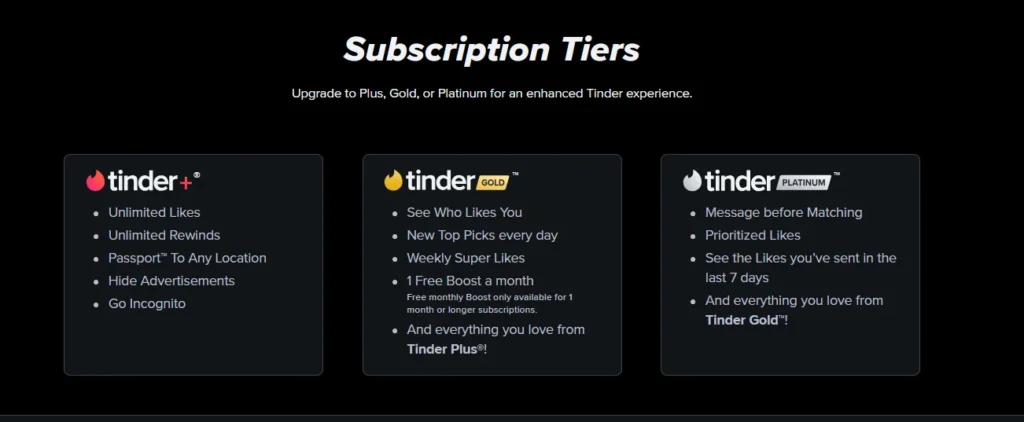
Tinder Plus: This was the first premium tier. It offers features like Unlimited Swipes, Rewind (to undo an accidental left swipe), and Passport (to change your location and swipe in other cities).
Tinder Gold: This includes all the features of Plus, but adds the most popular premium feature: “Likes You.” This allows you to see a list of everyone who has already swiped right on you, so you can get an instant match.
Tinder Platinum: The highest tier. It includes all the features of Gold, plus Priority Likes (your profile gets shown to people you like before non-subscribers) and the ability to Message Before Matching by attaching a message to your Super Like.
À La Carte Features: Users can also buy individual perks, like Super Likes (to show someone you're very interested) and Boosts (to temporarily make your profile one of the top profiles in your area).
This multi-layered strategy means there is a price point for everyone, from the casual user who just wants unlimited swipes to the serious dater who wants every possible advantage.
Tinder's Revenue Growth Over the Years
| Year | Annual Revenue (in millions) | Key Insight |
| 2015 | $47 | Just getting started with its premium model. |
| 2018 | $805 | Explosive growth as Tinder Gold becomes a massive hit. |
| 2021 | $1,649 | Continued dominance and maturity in the market. |
| 2024 | $1,940 | Slower growth, but still an incredibly profitable business. |
Who’s Really Using Tinder? A Look at Its Users
Understanding who uses Tinder is key to understanding the platform's culture and dynamics. The data reveals a user base that is overwhelmingly young, predominantly male and spread across various income levels.
Age Demographics: A Young Person's Game
Tinder is, without a doubt, most popular with younger generations.
- An incredible 61.2% of all Tinder users are between the ages of 18 and 34.
Here is a full breakdown of the user base by age:
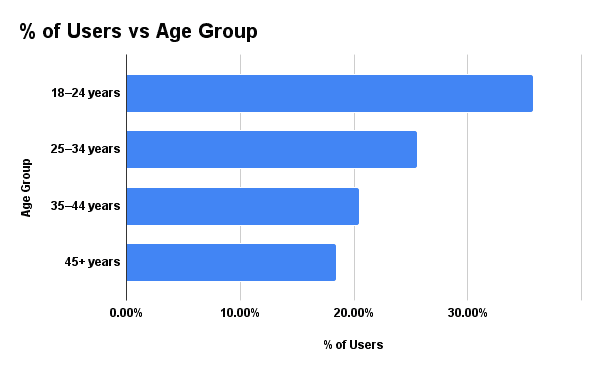
| Age Group | % of Users | Summary |
|---|---|---|
| 18–24 years | 35.7% | Millennials are seeking both casual and serious relationships. |
| 25–34 years | 25.5% | Mid-age users showing that Tinder isn’t just for 20-somethings. |
| 35–44 years | 20.4% | Older users are growing steadily in the online dating space. |
| 45+ years | 18.4% | Mid-age users show that Tinder isn’t just for 20-somethings. |
While Tinder is a young person's world, the fact that nearly 40% of its users are over 35 shows that its appeal is broadening.
Gender Demographics: The Big Imbalance
This is one of the most talked-about statistics when it comes to Tinder. The platform has a significant gender imbalance.
- Male Users: 75.8%
- Female Users: 24.2%
[Image: A simple pie chart clearly showing a 76% male slice and a 24% female slice.]
This means that for every female user on Tinder, there are roughly three male users. This has a profound impact on the user experience:
- For Men: The competition is incredibly high. Men have to work harder to stand out and are likely to get far fewer matches.
- For Women: They are likely to receive a very high volume of likes and messages, which can be both flattering and overwhelming.
It's interesting to note that this gender ratio changes by region. In countries like India, the male user base is even larger. However, in Europe, the ratio is much closer to an even 50/50 split.
Where in the World is Tinder Most Popular?
While Tinder is available in 190 countries, a few key markets dominate its user base.
- The United States is by far the biggest market, with 7.8 million active Tinder users.
- The United Kingdom comes in second with 5 million users.
- Other top countries include Brazil, Canada, France, Australia, and Germany.
This shows that while Tinder has a massive global footprint, its core strength lies in Western countries.
How People Actually Use the App: Behavior and Swipe Secrets
Beyond the basic demographics, the way people behave on Tinder is fascinating. These statistics reveal the psychology behind the swipes.
Men Swipe Right More Often Than Women
This is a well-known phenomenon backed by data. Men and women approach swiping with very different strategies.
- Men swipe right on approximately 46% of the profiles they see. They tend to use a “casting a wide net” approach, swiping right on many profiles and then deciding who to talk to from their matches.
- Women swipe right on approximately 14% of the profiles they see. They are far more selective, carefully evaluating profiles before deciding to like someone.
This difference in behavior directly contributes to the gender imbalance in matches.
What Makes a Successful Profile?
What actually convinces someone to swipe right? The data gives us some clear clues.
- Photos are Everything: Having at least 3-4 photos dramatically increases your chances of getting a match compared to having just one. Profiles with only one photo are often seen as fake or low-effort.
- Smile! Profiles, where the person is smiling in their main photo, receive significantly more right swipes. It makes you seem more approachable and friendly.
- Don't Skip the Bio: While photos are crucial, a bio is your chance to show some personality. A witty or interesting bio can be the deciding factor. In fact, profiles with a bio get far more matches than those without one.
- Connect Your Socials: Linking your Instagram or Spotify account adds a layer of authenticity and gives potential matches more insight into your life and tastes.
The “Hookup App” Reputation: Is It True?
Tinder has long had a reputation for being a “hookup app” for casual encounters. While that is certainly a part of its culture, it's not the whole story.
- According to surveys, only about 22% of users say they use Tinder primarily for hookups.
- A much larger group, around 44% say they are looking for long-term relationship potential.
- The rest are there for a mix of reasons, including making friends, boosting their confidence, or simply out of curiosity.
This shows that while the “hookup app” label has stuck, a huge portion of the user base is looking for something more meaningful.
Tinder vs. The World: How it Stacks Up Against Competitors
Tinder is no longer the only player in the game. Fierce competition has emerged, primarily from Bumble and Hinge.
- Bumble: Known as the “feminist” dating app, where women have to make the first move. This feature has made it incredibly popular with women who are tired of being bombarded with messages.
- Hinge: Marketed as the app that's “designed to be deleted.” It focuses on creating deeper connections through detailed profiles and ice-breaker prompts, attracting users who are serious about finding a relationship.
While Tinder still has the most market share in the US, Bumble is not far behind. This competition is the primary reason for Tinder's recent dip in subscribers, as users now have high-quality alternatives to choose from.
Quick links:
- YouTube Shorts Statistics: Users, Growth & Revenue
- iPhone User Statistics: Latest Data & Trends
- X (Twitter) Statistics: Active Users, Trends & Growth
- ChatGPT Statistics : Amount of Users & Queries
- Google Gemini Statistics : Usage, Growth, Key Facts & Figures
Conclusion
In 2025, Tinder is still a major force in online dating, with millions of users and strong revenue. It's especially popular with young men and plays a big role in modern social life.
But growth is slowing, and competition from apps like Bumble and Hinge is rising. To stay on top, Tinder must evolve, fix the gender gap, improve safety, and show it's more than just a hookup app.
Still, with 60 million users swiping monthly, Tinder isn’t fading; it’s just entering a tougher game.

